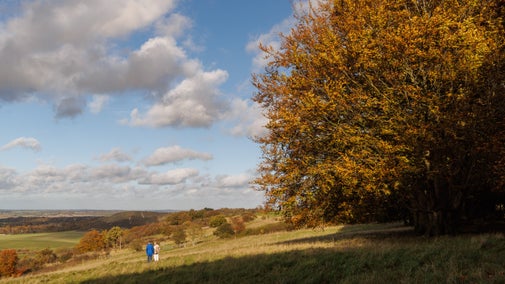Hatfield Forest walk
Essex, Bedfordshire & Hertfordshire
Enjoy the varied scenery on this circular walk at Hatfield Forest as you discover the sights that make it a National Nature Reserve and a Site of Special Scientific Interest. Follow the rides and visit Portingbury Hills. Look out for evidence of coppicing.
Near to
Hatfield ForestStart point
Shell House, grid ref: TL540197Trail information
Plan ahead
The area around Portingbury Hills can be become very muddy in later autumn and winter so this walk is best enjoyed from April to October. Please note that there are no longer any waymarkers for this trail.
More near here
Hatfield Forest and Flitch Way walk
Enjoy the splendour of a medieval hunting forest, passing through ancient trees on the Hatfield Forest and Flitch Way walk.

Get in touch
Bush End Road, Takeley, Bishop's Stortford, Essex, CM22 6NE
Our partners

We’ve partnered with Cotswold Outdoor to help everyone make the most of their time outdoors in the places we care for.
You might also be interested in
Walking
Explore some of the finest landscapes in our care on coastal paths, accessible trails, woodland walks and everything in between. Find the best places to walk near you.

Walking in Essex, Bedfordshire and Hertfordshire
From long forest wanders to a gentle amble to a famous literary hut, these are some of the best walks around Essex, Bedfordshire and Hertfordshire.

Outdoor activities at Hatfield Forest
Discover a range of outdoor activities at Hatfield Forest in Essex. From short to long walks, running routes, horse riding and fishing, there's something for everyone.

Visiting Hatfield Forest with your dog
Hatfield Forest is a two pawprint rated place. It's a perfect place for walking your dog, with 1,000 acres of woodland and open grassland to explore, trees to sniff and grass to roll around in. Professional dog walkers will need a National Trust license to walk a maximum of 4 dogs, up to three times a day.

Deer at Hatfield Forest
Hatfield Forest is home to an established population of both fallow and muntjac deer. Visit the coppices to see how many you can find.

Follow the Countryside Code
Help to look after National Trust places by observing a few simple guidelines during your visit and following the Countryside Code.

Cotswold Outdoor: our exclusive walking partner
Learn about the National Trust’s ongoing partnership with Cotswold Outdoor. Find out how they help us care for precious places and the exclusive discount available for National Trust supporters.

Staying safe at National Trust places
The special places in National Trust care sometimes come with a few risks for visitors, be it coastline or countryside. Find out how to keep safe throughout your visits.



